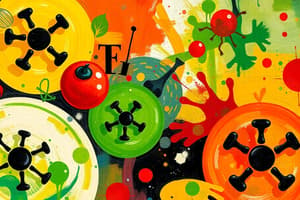Podcast
Questions and Answers
What are some symptoms of Diarrhetic Shellfish Poisoning (DSP)?
What are some symptoms of Diarrhetic Shellfish Poisoning (DSP)?
Symptoms include abdominal cramping, secretory diarrhea, nausea, vomiting, and watery diarrhea.
What is the neurotoxin that causes Amnesic Shellfish Poisoning (ASP)?
What is the neurotoxin that causes Amnesic Shellfish Poisoning (ASP)?
- Domoic acid (correct)
- Glutamate
- Azaspiracid
- Histamine
Aflatoxins are produced by bacteria.
Aflatoxins are produced by bacteria.
False (B)
Phytohemagglutinins are proteins capable of binding to specific __________ residues.
Phytohemagglutinins are proteins capable of binding to specific __________ residues.
What is the main concern with long-term exposure to mycotoxins such as aflatoxin?
What is the main concern with long-term exposure to mycotoxins such as aflatoxin?
What are naturally occurring toxins?
What are naturally occurring toxins?
Cooking or peeling can deactivate toxins in poisonous mushrooms.
Cooking or peeling can deactivate toxins in poisonous mushrooms.
What is fugu?
What is fugu?
What is the purpose of glycoalkaloid solanine and chaconine in plants?
What is the purpose of glycoalkaloid solanine and chaconine in plants?
Neurotoxic shellfish poisoning is caused by consuming shellfish contaminated with ________________.
Neurotoxic shellfish poisoning is caused by consuming shellfish contaminated with ________________.
Eating tubers with a high concentration of solanine is safe.
Eating tubers with a high concentration of solanine is safe.
Natural toxins in food can cause adverse health effects and pose a serious health threat to both humans and livestock due to their __________.
Natural toxins in food can cause adverse health effects and pose a serious health threat to both humans and livestock due to their __________.
Match the following organizations with their roles in evaluating natural toxins in food:
Match the following organizations with their roles in evaluating natural toxins in food:
What actions should be taken to consume tubers safely according to the text?
What actions should be taken to consume tubers safely according to the text?
Flashcards are hidden until you start studying
Study Notes
Naturally Occurring Toxicants as Aetiology Agents of Food Borne Diseases
- Definition: Natural toxins are toxic compounds produced by living organisms, not harmful to the organisms themselves but toxic to other creatures, including humans, when eaten.
- Sources:
- Plants as a natural defense mechanism against predators, insects, or microorganisms.
- Microscopic algae and plankton in oceans or lakes that produce toxins harmless to fish or shellfish but toxic to humans.
- Fungi and plant toxins.
Mycotoxins
- Definition: Toxic compounds produced by fungi, including molds, that can contaminate food crops.
- Examples:
- Aflatoxins produced by Aspergillus flavus and A. parasiticus.
- Ochratoxins produced by Aspergillus ochraceus and Penicillium verrucosum.
- Found in:
- Staple foods like corn, cereals, nuts, and seeds.
- Can cause long-term exposure effects on the immune system, normal development, and cancer.
Ciguatera Fish Poisoning
- Caused by: Ciguatoxin produced by marine microalgae (Gambierdiscus toxicus).
- Found in: Reef fishes in the Pacific and northern Caribbean.
- Symptoms:
- Numbness and tingling of the lips, tongue, and mouth.
- Gastrointestinal disturbances, including vomiting and diarrhea.
- Muscle weakness and paralysis.
Puffer Fish Poison - Tetrodotoxin
- Produced by: Puffer fish (Takifugu spp.).
- Found in: Liver, ovaries, eggs, and skin of puffer fish.
- Toxicity:
- Can be fatal if ingested in large amounts.
- Can cause numbness, tingling, and paralysis.
Neurotoxic Shellfish Poisoning (NSP)
- Caused by: Brevetoxins produced by marine dinoflagellate (Karenia brevis).
- Found in: Shellfish, including clams, mussels, and oysters.
- Symptoms:
- Numbness and tingling in the mouth and legs.
- Loss of coordination.
- Diarrhea and vomiting.
Paralytic Shellfish Poisoning (PSP)
- Caused by: Saxitoxins produced by marine dinoflagellates (Alexandrium catenella).
- Found in: Shellfish, including mussels, clams, and scallops.
- Symptoms:
- Gastrointestinal disturbances.
- Numbness and tingling in the mouth and lips.
- Muscle weakness and paralysis.
Diarrhetic Shellfish Poisoning (DSP)
- Caused by: Okadaic acid and dinophysistoxins produced by dinoflagellates (Dinophysis spp.).
- Found in: Shellfish, including mussels, clams, and scallops.
- Symptoms:
- Diarrhea and abdominal cramps.
- Nausea and vomiting.
- Fever and headache.
Amnesic Shellfish Poisoning (ASP)
- Caused by: Domoic acid produced by marine diatom (Nitzschia spp.).
- Found in: Shellfish, including mussels, clams, and scallops.
- Symptoms:
- Nausea and vomiting.
- Diarrhea and abdominal cramps.
- Memory loss and confusion.
Azaspiracid Shellfish Poisoning (AZP)
- Caused by: Azaspiracid and its analogues produced by marine dinoflagellates (Azadinium spp.).
- Found in: Shellfish, including mussels, clams, and scallops.
- Symptoms:
- Gastrointestinal disturbances.
- Nausea and vomiting.
- Diarrhea and abdominal cramps.
Scombroid Food Poisoning (SFP)
- Caused by: Histamine produced by bacterial decomposition of fish.
- Found in: Spoiled fish, especially tuna, mackerel, and bonito.
- Symptoms:
- Nausea and vomiting.
- Diarrhea and abdominal cramps.
- Headache and skin rash.
Mushroom Poisoning
- Caused by: Toxins produced by various mushroom species.
- Symptoms:
- Nausea and vomiting.
- Diarrhea and abdominal cramps.
- Confusion, visual disturbances, and hallucinations.
Aflatoxins
-
Definition: Toxic substances produced by Aspergillus flavus and A. parasiticus.
-
Found in: Contaminated food crops, including nuts, cereals, and seeds.
-
Effects:
- Can cause liver damage and cancer.
- Can be present in milk and milk products, including breast milk.### History of Animal Health Implications
-
By the mid-20th century, improved methods of feed handling, production, and storage reduced the occurrence of disorders in farm animals.
-
However, it wasn't until 1960 that the human health implications of these disorders began to be clearly recognized.
-
In 1960, a disease dubbed "turkey-X disease" affected over 100,000 young turkeys in England, characterized by liver necrosis.
-
Around the same time, an increasing mortality and liver tumors were observed in hatchery-raised trout in Oregon.
Aflatoxins
- Aflatoxins are potent carcinogens that can affect any organ or system, especially the liver and kidney.
- They cause liver cancer and have been linked to other cancers.
- AFB1 is carcinogenic to humans, and the hepatocarcinogenic potency of aflatoxins is significantly increased in the presence of hepatitis B virus (HBV) infection.
- Aflatoxins are mutagenic, genotoxic, and may cause birth defects in children.
- Acute intoxication with a high dose of aflatoxin can result in fulminant hepatic failure and rhabdomyolysis.
- Chronic exposure to aflatoxin can result in liver cirrhosis and ultimately lead to hepatocellular carcinoma, as well as gall bladder carcinoma.
Lectins
- Lectins are natural compounds found in legumes, beans, peas, and lentils, which can bind to and clump together red blood cells.
- Lectins interfere with nutrient absorption from the intestines.
- Many types of beans contain toxins called lectins, with kidney beans having the highest concentrations, especially red kidney beans.
- As few as 4 or 5 raw beans can cause severe stomachache, vomiting, and diarrhea.
- Lectins are destroyed when dried beans are soaked for at least 12 hours and then boiled vigorously for at least 10 minutes in water.
Phytohemagglutinin (Red Kidney Bean Poisoning)
- Phytohemagglutinin is a sugar-based protein (glycoprotein) that is the main cause of toxin in red kidney beans.
- Some of the highest concentrations of this glycoprotein have been found in red kidney beans.
Solanines and Chaconine
- Solanines and chaconine are natural toxins found in potatoes, tomatoes, and eggplants.
- They can accumulate to high levels in greened, stored, damaged potatoes, causing acute poisoning, including gastro-intestinal and neurological disturbances.
- Potatoes with a high concentration of solanine will taste bitter and can be harmful if eaten in large quantities.
- To reduce the production of solanines and chaconine, potatoes should be stored in a dark, cool, and dry place, and green or sprouting parts should not be eaten.
Key Facts
- Natural toxins can be formed in food as defense mechanisms of plants, through their infestation with toxin-producing mold, or through ingestion by animals of toxin-producing microorganisms.
- Natural toxins can cause a variety of adverse health effects, posing a serious health threat to both humans and livestock.
- Some of these toxins are extremely potent.
- Adverse health effects can be acute poisoning, ranging from allergic reactions to severe stomachache and diarrhea, and even death.
- Long-term health consequences include effects on the immune, reproductive, or nervous systems, and also cancer.
Studying That Suits You
Use AI to generate personalized quizzes and flashcards to suit your learning preferences.




